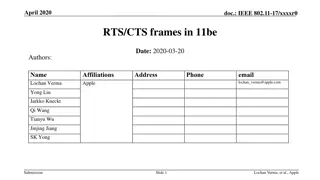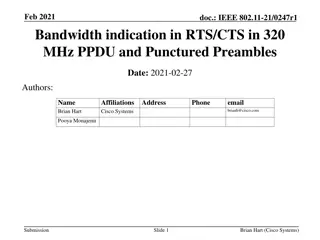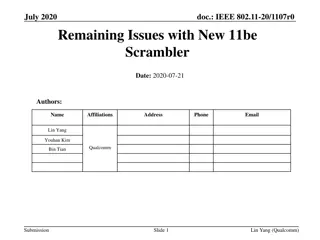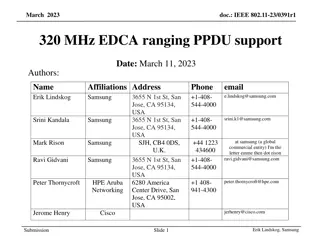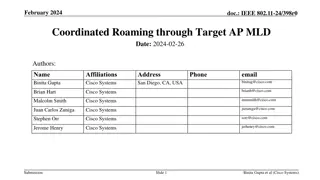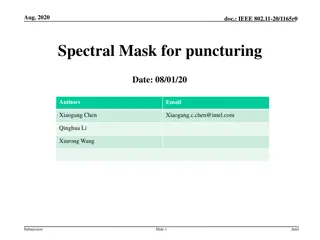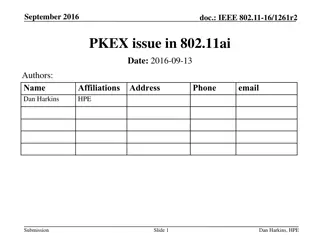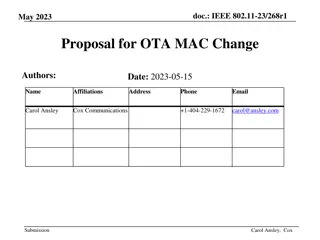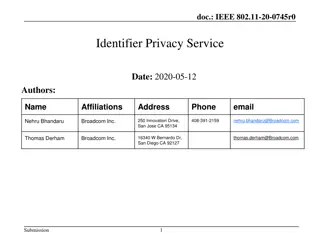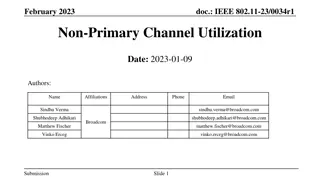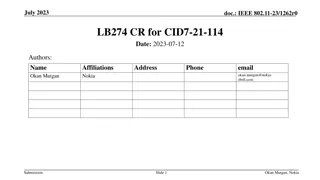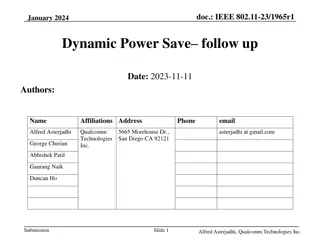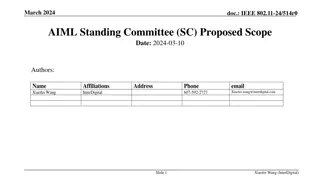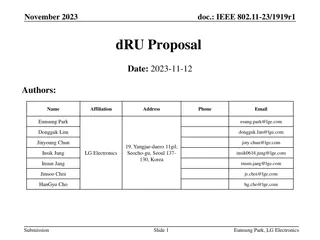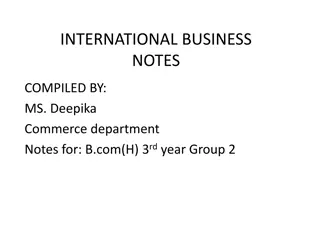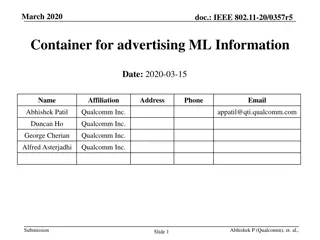IEEE 802.11-20/1583r1 MU-RTS and CTS Exchange Proposal
Submission outlines a proposal for exchanging Multi-User Request to Send (MU-RTS) and Clear to Send (CTS) frames with Enhanced High Throughput (EHT) Sub-Channel Selective (SST) STAs. It discusses channel signaling, frame transmission, proximity protection, operating bandwidth, and reservation process for successful data transmission in IEEE 802.11 networks.
Download Presentation

Please find below an Image/Link to download the presentation.
The content on the website is provided AS IS for your information and personal use only. It may not be sold, licensed, or shared on other websites without obtaining consent from the author. Download presentation by click this link. If you encounter any issues during the download, it is possible that the publisher has removed the file from their server.
E N D
Presentation Transcript
October 2020 doc.: IEEE 802.11-20/1583r1 MU-RTS to SST-STAs Date: 2020-10-07 Authors: Name Jarkko Kneckt, Yong Liu, Jinjing Jiang, Tianyu Wu, Qi Wang, SK Yong Affiliations Address Apple Inc. Phone email jkneckt@apple.com Cupertino, CA Submission Slide 1 Jarkko Kneckt, Apple
October 2020 doc.: IEEE 802.11-20/1583r1 Abstract This submission provides means for Sub-Channel Selective (SST) STAs to receive MU-RTS and transmit CTS as a response. Submission Slide 2 Jarkko Kneckt, Apple
October 2020 doc.: IEEE 802.11-20/1583r1 Recap, SST STA in 802.11ax A STA and AP may setup an individual trigger-enabled TWT agreement to schedule the times when the STA operates in SST mode 20 MHz SST STA may operate in any secondary channel The PPDU reception rules are similar to the primary 20 channel The 80 MHz SST STA may operate in the secondary 80 MHz channel The 80 MHz SST STA does not have a primary channel: STA receives HE MU and non-HT Duplicate PPDUs that are transmitted over the whole 80 MHz channel 80 MHz SST STA channel RU to 80 MHz SST STA 1 20 MHz SST STA channel RU to 20 MHz SST STA 2 RU to STA 3 EDCA Primary Channel Jarkko Kneckt, Apple Submission Slide 3
October 2020 doc.: IEEE 802.11-20/1583r1 Recap, MU-RTS and CTS MU-RTS may trigger CTS frame transmission from one or more STAs The MU-RTS signals the channels in which the responding STAs transmit CTS if the channel(s) are IDLE The CTS is always transmitted to the primary channel The triggered STAs transmit CTS frames in the same format as specified in 802.11ax D7.0 clause 26.2.6.3(CTS Response to MU-RTS Trigger frame) This ensures that CTS frames have the same duration and content AP can receive CTS frames transmitted by multiple STAs on the same channel Submission Slide 4 Jarkko Kneckt, Apple
October 2020 doc.: IEEE 802.11-20/1583r1 Proposal1: MU-RTS and CTS exchange with EHT SST STA 1. CCA and NAV are obtained from the STA that receives DL transmission. transmission 2. CTS protects the proximity of the STA that receives 3. EHT SST STAs may operate outside the operating BW of the non- SST STAs. 4. Multiple responding STAs in primary channel make successful reservation likely SIFS, CCA is done at the same time in all STAs Submission Slide 5 Jarkko Kneckt, Apple
October 2020 doc.: IEEE 802.11-20/1583r1 MU-RTS response alternatives Case 1) AP does not receive CTS on any channel MU-RTS fails; AP obtains new TXOP through EDCA Case 2) AP receives CTS on the primary channel AP follows the legacy rules and uses the reserved BW for TXOP Case 3) AP receives CTS only from the SST-STA(s) The primary channel is not reserved by the MU-RTS frame Two alternatives to continue TXOP: AP may ignore the reservation on its secondary channels; TXOP fails AP may transmit only on the secondary channels It is up to AP implementation to select its operation The following slides explain the alternatives Submission Slide 6 Jarkko Kneckt, Apple
October 2020 doc.: IEEE 802.11-20/1583r1 Summary of proposal2, operation when CTS is received only on secondary channels Alternative1: No data TX, AP may ignore the reservation STA1 CCA ED STA2 CCA ED STA3 CCA ED STA4 CCA ED STA5 CCA ED AP s CCA ED MU-RTS(STA1, SST-STA 2,3,4,5) CTS MU-RTS(STA1, SST-STA 2,3,4,5) BA DL MU-Data to SST-STA 5 CTS MU-RTS(STA1, SST-STA 2,3,4,5) CTS MU-RTS(STA1, SST-STA 2,3,4,5) BA DL MU-Data to SST-STA 4 CTS MU-RTS(STA1, SST-STA 2,3,4,5) CTS MU-RTS(STA1, SST-STA 2,3,4,5) CTS MU-RTS(STA1, SST-STA 2,3,4,5) DL MU-Data to SST-STA 3 BA CTS MU-RTS(STA1, SST-STA 2,3,4,5) CTS MU-RTS(STA1, SST-STA 2,3,4,5) Alternative2: AP data transmission on secondary channels CTS CTS MU-RTS(STA1, SST-STA 2,3,4,5) CTS CTS MU-RTS(STA1, SST-STA 2,3,4,5) DL MU-Data to SST-STA 2 BA CTS MU-RTS(STA1, SST-STA 2,3,4,5) CTS MU-RTS(STA1, SST-STA 2,3,4,5) MU-RTS(STA1, SST-STA 2,3,4,5) MU-RTS(STA1, SST-STA 2,3,4,5) EDCA MU-RTS(STA1, SST-STA 2,3,4,5) SIFS, CCA is done at the same time in all STAs Jarkko Kneckt, Apple Submission Slide 7
October 2020 doc.: IEEE 802.11-20/1583r1 Alternative 1: Secondary channel reservation is ignored Case: AP got CTS only on the secondary channels AP may ignore the reservation and obtain new TXOP through EDCA The AP is always present in the primary channel, but the secondary channel reservations may be wasted for OBSSs This scheme may be useful, if the AP has associated STAs that are not HE or EHT STAs AP ignores reservation in secondary channels CCA ED during the same SIFS Slide 8 Submission Jarkko Kneckt, Apple
October 2020 doc.: IEEE 802.11-20/1583r1 Alternative 2: AP transmits on reserved secondary channels The AP may transmit on successfully reserved secondary channels This is like triggered UL transmission: A triggered STA may sense primary channel BUSY, but a triggered STA may sense secondary channel IDLE and transmit on the secondary channel The MU-RTS frame can request multiple STAs to transmit CTS on the primary channel Multiple responding STAs may have higher likelihood to sense the primary channel IDLE and avoid hidden terminal problems Submission Slide 9 Jarkko Kneckt, Apple
October 2020 doc.: IEEE 802.11-20/1583r1 Recap, MU-RTS frame primary channel protection All STAs set NAV when they receive MU-RTS frame An HE or EHT STA may reset NAV, if it does not receive a preamble within a MU-RTS timeout Legacy STAs cannot reset the NAV set by MU-RTS frame AP should configure HE and EHT STAs to initiate UL EDCA transmissions with RTS CTS AP may set TXOP Duration Threshold subfield in HE Operation Parameters element to 1 The RTS CTS protects the STAs from gaining to the media, if the AP is transmitting to SST-STAs Submission Slide 10 Jarkko Kneckt, Apple
October 2020 doc.: IEEE 802.11-20/1583r1 Motivation: Shorter MU-RTS frame Short MU-RTS provides better protection against hidden STAs The triggered STAs may transmit CTS before transmissions from hidden STAs The MU-RTS frame is transmitted in low TX Rate Packet size increases transmission duration @6 Mbit/s TX rate only 26 bits fit in one ~4 s symbol Submission Slide 11 Jarkko Kneckt, Apple
October 2020 doc.: IEEE 802.11-20/1583r1 Proposal 3: MU-RTS frame transmission per 80 MHz MU-RTS frame is transmitted as a non-HT Duplicate PPDU 802.11be allows PPDUs to carry a different payload in each 80 MHz channel The MU-RTS frame on secondary, tertiary or quaternary 80 MHz channel may contain User Info fields only to the EHT SST STAs The MU-RTS frame transmission to SST-STAs may not increase the transmission duration of the MU-RTS frame Submission Slide 12 Jarkko Kneckt, Apple
October 2020 doc.: IEEE 802.11-20/1583r1 Recap, Packet Reception Channel 1. SST-STA Receives MU-RTS on Packet Detection channel [2] 2. The UL BW field of the MU-RTS frame signals the channels in which SST-STA transmits CTS. The SST-STA calculates the reserved channels from the Packet Detection Channel. SIFS [2] 20/736r2 EHT SST Operation, Mediatek Submission Slide 13 Jarkko Kneckt, Apple
October 2020 doc.: IEEE 802.11-20/1583r1 Proposal 4: Partial response to MU-RTS The MU-RTS may allow an (SST-) STA to reserve a subset of the requested channels Successful reservation is more likely if a busy secondary channel does not prevent CTS transmission The SST-STA may send CTS on channels in which the AP is capable to transmit punctured PPDU SIFS Submission Slide 14 Jarkko Kneckt, Apple
October 2020 doc.: IEEE 802.11-20/1583r1 Summary The submission proposed MU-RTS CTS signalling for SST-STAs The DL transmissions to SST-STAs can have hidden terminal protection Submission Slide 15 Jarkko Kneckt, Apple
October 2020 doc.: IEEE 802.11-20/1583r1 SP 1 Do you support that 802.11be R2 allows AP to send an MU-RTS frame that requests CTS response from one or more EHT SST-STAs? - The EHT SST-STAs respond with CTS if the requested channels are IDLE - TDB whether SST-STA have additional capability to to send CTS on a subset of the requested channels Submission Slide 16 Jarkko Kneckt, Apple
October 2020 doc.: IEEE 802.11-20/1583r1 SP 2 Do you support that 802.11be R2 allows MU-RTS frame to have contains different payload at different 80 MHz channels? Submission Slide 17 Jarkko Kneckt, Apple
October 2020 doc.: IEEE 802.11-20/1583r1 SP 3 Do you support that 802.11be R2 STA has optional capability to send CTS as a response to the MU-RTS frame on a subset of the triggered channels? - The MU-RTS frame signals whether a STA is allowed to transmit CTS on subset of the triggered channels Submission Slide 18 Jarkko Kneckt, Apple


